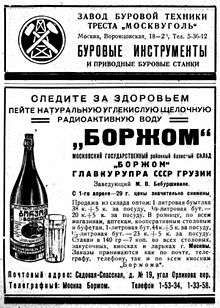Radioactive quackery
Radioactive quackery is quackery that improperly promotes radioactivity as a therapy for illnesses. Unlike radiotherapy, which is the scientifically sound use of radiation for the destruction of cells (usually cancer cells), quackery involving radioactive substances pseudoscientifically promotes radiation as healthful and healing for cells and tissues. It was most popular during the early 20th century, after the discovery in 1896 of radioactive decay.[1] The practice has widely declined, but is still actively practiced by some.[2]
"Tho-radia" powder, based on radium and thorium, according to the formula of Dr. Alfred Curie (not related to Pierre and Marie Curie)

A Borjomi mineral water ad from 1929, advertising the water as "radioactive". The water is still popular today, but said property is no longer emphasized.
Notable examples
- Radithor, a solution of radium salts, which was claimed by its developer William J. A. Bailey to have curative properties. The industrialist Eben Byers died in 1932 from ingesting it in large quantities throughout 1927–1930.[3][4]
- Many brands of toothpaste were laced with radioactive substances that were claimed to make teeth shine whiter, such as Doramad Radioactive Toothpaste.[5]
- Bath and bathing waters were advertised positively as being "highly radioactive" and with a "curative value", e.g., in a New Zealand Thames Star Supplement report from 1912.[6]
- Revigator pots, which added radon to drinking water.[1]
- Uranium sand houses, where patients would sit on benches in a round room that had a floor composed of mildly radioactive sand (usually beach sand with crushed minerals like carnotite). These were popular in Utah, New Mexico, and Colorado during the 1950s.[7]
- Lying in a narrow box with sands that reputedly contained uranium ore was promoted as a treatment for arthritis, bursitis, and rheumatism as late as 1956.[8]
- The NICO Clean Tobacco Card was a device exported from Japan to the United States in the 1960s, consisting of a small card impregnated with uranium ore. The card was to be placed inside a pack of cigarettes, and the producers claimed that the radiation emitted by the card would reduce tar and nicotine.
| Wikimedia Commons has media related to Radioactive quackery. |
gollark: Also tracking everyone else, so I'm against that sort of thing.
gollark: Yes, no need to add more of them.
gollark: Isn't that... still bad, then?
gollark: What cars?
gollark: I suppose they may get around this by not storing locations, but I'm not sure what they do and don't gather.
See also
References
- Gray, Theodore (August 2004). "For That Healthy Glow, Drink Radiation!". Popular Science. Bonnier Corporation. 265 (2): 28. ISSN 0161-7370.
- Gadbow, Daryl (4 July 2004). "State of mine: Many swear to benefits of inhaling radon". Missoulian. Retrieved 2013-09-18.
- Macklis, R. M. (1990). "The radiotoxicology of Radithor. Analysis of an early case of iatrogenic poisoning by a radioactive patent medicine". JAMA: The Journal of the American Medical Association. 264 (5): 619–621. doi:10.1001/jama.264.5.619. ISSN 0098-7484.
- Goldsmith, Barbara (2005). Obsessive Genius: The Inner World of Marie Curie. W. W. Norton & Company. pp. 119–120. ISBN 0-393-05137-4.
- Matricon, Jean; Waysand, G. (2003). The Cold Wars: A History of Superconductivity. Rutgers University Press. p. 113. ISBN 0-8135-3295-7.
- Radium Baths, Thames Star, Oct. 19, 1912, p. 2.
- Seff, Philip; Seff, Nancy R. (1996). Petrified lightning and more amazing stories from "Our fascinating earth". Chicago, Ill.: Contemporary Books. p. 18. ISBN 0-8092-3250-2.
- Kelly, Bella. "Clinic Plugs Uranium Sand 'Cures'". Miami News, July 29, 1956, pp. 1A, 14A. Retrieved on June 24, 2013.
External links
- L’histoire étonnante du Tho-Radia, by Thierry Lefebvre and Cécile Raynal (in French)
- Radioactive Quack Cures at the Museum of Oak Ridge Associated Universities
This article is issued from Wikipedia. The text is licensed under Creative Commons - Attribution - Sharealike. Additional terms may apply for the media files.